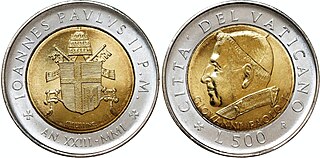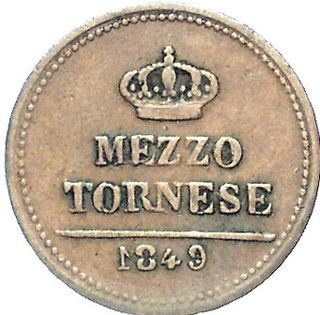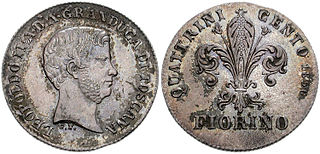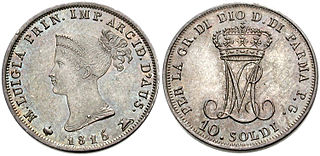
The svenska riksdaler was the name of a Swedish coin first minted in 1604. Between 1777 and 1873, it was the currency of Sweden. The daler, like the dollar, was named after the German Thaler. The similarly named Reichsthaler, rijksdaalder, and rigsdaler were used in Germany and Austria-Hungary, the Netherlands, and Denmark-Norway, respectively. Riksdaler is still used as a colloquial term for krona, Sweden's modern-day currency.

Kuruş, also gurush, ersh, gersh, grush, grosha, and grosi, are all names for currency denominations in and around the territories formerly part of the Ottoman Empire. The variation in the name stems from the different languages it is used in and the different transcriptions into the Latin alphabet. In European languages, the kuruş was known as the piastre.

The lira was the currency of Italy between 1861 and 2002. It was introduced by the Napoleonic Kingdom of Italy in 1807 at par with the French franc, and was subsequently adopted by the different states that would eventually form the Kingdom of Italy in 1861. It was subdivided into 100 centesimi, which means "hundredths" or "cents". The lira was also the currency of the Albanian Kingdom from 1941 to 1943.

The rigsdaler was the name of several currencies used in Denmark until 1875. The similarly named Reichsthaler, riksdaler and rijksdaalder were used in Germany and Austria-Hungary, Sweden and the Netherlands, respectively. These currencies were often anglicized as rix-dollar or rixdollar.

The scudo was the name for a number of coins used in various states in the Italian peninsula until the 19th century. The name, like that of the French écu and the Spanish and Portuguese escudo, was derived from the Latin scutum ("shield"). From the 16th century, the name was used in Italy for large silver coins. Sizes varied depending on the issuing country.

The lira was the currency of the Vatican City between 1929 and 2002. It was not a separate currency but an issue of the Italian lira; the Banca d'Italia produced coins specifically for Vatican City.

The lira was the currency of San Marino from the 1860s until it was replaced by the euro on 1 January 2002. It was equivalent and pegged to the Italian lira. Italian coins and banknotes and Vatican City coins were legal tender in San Marino, while Sammarinese coins, minted in Rome, were legal tender throughout Italy, as well as in the Vatican City.
The florin was the currency of Lombardy-Venetia between 1862 and 1866.
The lira austriaca was the currency of the Kingdom of Lombardy–Venetia.

The ducat was the main currency of the Kingdom of the Two Sicilies between 1816 and 1860. When the Congress of Vienna created the kingdom merging the Kingdom of Naples and the Kingdom of Sicily, the ducat became at par a continuation of the Neapolitan ducat and the Sicilian piastra issued prior to 1816, although the Sicilian piastra had been subdivided into 240 grana. In the mainland part of the kingdom, the ducat also replaced the Napoleonic lira.

The Tuscan fiorino was the currency of Tuscany between 1826 and 1859. It was subdivided into 100 quattrini, a local currency made by four denari. There was an additional denomination called the paolo, worth 40 quattrini, in circulation.

The Roman scudo was the currency of the Papal States until 1866. It was subdivided into 100 baiocchi, each of 5 quattrini. Other denominations included the grosso of 5 baiocchi, the carlino of 7+1⁄2 baiocchi, the giulio and paoli both of 10 baiocchi, the testone of 30 baiocchi and the doppia of 3 scudi.

The lira was the currency of the Papal States between 1866 and 1870. It was subdivided into 20 soldi, each of 5 centesimi.
The lira was the distinct currency of Venice until 1848, when it was replaced by the Italian lira. It originated from the Carolingian monetary system used in much of Western Europe since the 8th century CE, with the lira subdivided into 20 soldi, each of 12 denari.
The lira was the currency of the Republic of Lucca until 1800 and again of the Duchy of Lucca between 1826 and 1847. It was subdivided into 20 soldi, each of 3 quattrini or 12 denari.

The lira was the distinct currency of Parma before 1802 and again from 1815 to 1859.
The Papal Mint is the pope's institute for the production of hard cash. Papal Mint also refers to the buildings in Avignon, Rome, and elsewhere that used to house the mint.

The rigsdaler specie was a unit of silver currency used in Norway from 1544, renamed as the speciedaler in 1816 and used until 1873. Norway used a common reichsthaler currency system shared with Denmark, Hamburg and Schleswig-Holstein until 1873 when the gold standard was implemented in Scandinavia and the German Empire.
The scudo was the currency of the island Kingdom of Sardinia until 1816.

Italy has a long history of different coinage types, which spans thousands of years. Italy has been influential at a coinage point of view: the medieval Florentine florin, one of the most used coinage types in European history and one of the most important coins in Western history, was struck in Florence in the 13th century, while the Venetian sequin, minted from 1284 to 1797, was the most prestigious gold coin in circulation in the commercial centers of the Mediterranean Sea.














